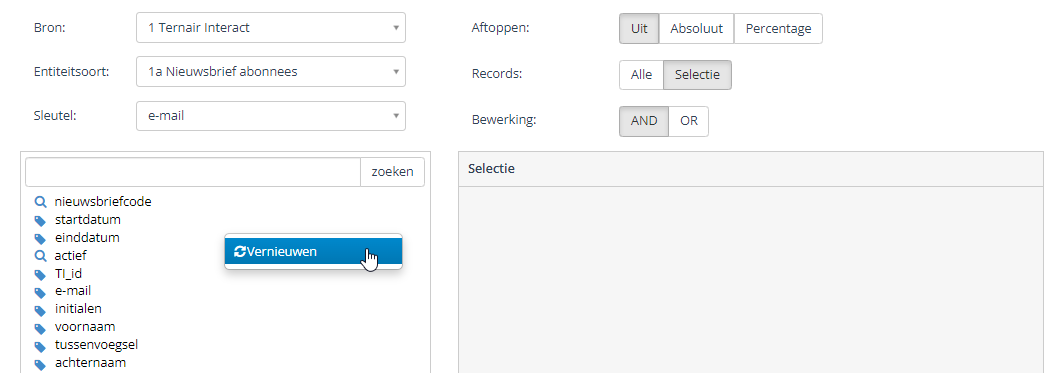Entities XML
Specifications XML Definition Entities
root: <Items>
under <Items> can contain 1 or more <Item>'s
an <Item>;
Required:
<O>: description. This is seen by the user.
<Id>: internal id. This is passed along to the sproc.
Optional:
<T>: type. Possible values:
Text (default)
Integer
Date
List: may only be at the one-lowest level. (this is the dropdown on the right)
Decimal: for decimal numbers (operational from TC 7.0)
<Preview>: true/false*. Default is false.
<Items>: group/tree items below.
<Operators>: comma-separated operator list.
Erft over. (can only be done on <Item>)
When not included, take default values depending on type (<T>)
Operators
xml: the representation in the entities XML
Text: shown to the user
Sproc input: representation sent to various stored procedures, such as 'calc_selection'.
Standard by... columns: If operators are not explicitly specified, then these operators are used
XML | Text | Sproc input | Standard at TEXT | Standard at Integer | Standard at List |
|---|---|---|---|---|---|
= | = | = | x | x | x |
!= | <> | <> | x | x | x |
gt | > | > | x | ||
ge | >= | >= | x | ||
lt | < | < | x | ||
le | <= | <= | x | ||
like | like | CONTAINS | x | ||
begin | begin | STARTS | x | ||
end | end | ENDS | x | ||
In | In | IN | x | ||
isempty | Is empty | ISEMPTY | x | x | |
isnotempty | Is not empty | ISNOTEMPTY | x | x |
Special characters
Sign | in XML |
|---|---|
& | & |
< | < |
≤ | ≤ |
> | > |
≥ | ≥ |
ë | ë |
Ë | Ë |
Example
1 2 3 4 5 6 7 8 9 10 11 12 13 14 15 16 17 18 19 20 21 22 23 24 25 26 27 28 29 30 31 32 33 34 | <Items> <Item> <Operators>=</Operators> <!-- default operators is overwritten.--> <O>Event (id)</O> <Id>event_description</Id> <T>INTEGER</T> </Item> <Item> <O>State</O> <Id>registrant_state</Id> <T>LIST</T> <Items> <Item> <O>Registered</O> <!-- Registered is used as <Id> --> </Item> <Item> <O>Stopped</O> </Item> <Item> <O>Visited</O> </Item> </Items> </Item> <Item> <O>Type of registration</O> <Id>registration_type</Id> <!-- <T> is Text here --> </Item> <Item> <O>Company name</O> <Id>company</Id> </Item> </Items> |
XML Tree View
Open a SELECT block
Select the entity
Right-click on the left pane
Choose refresh
The new XML definition appears
